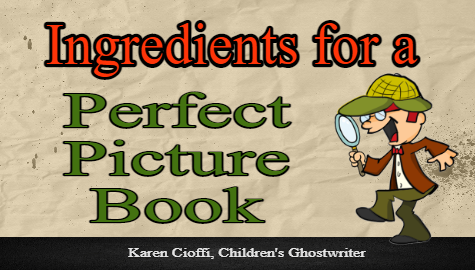Writing for young children can be tricky. It’s not as straightforward as writing for adults. You can’t use your own vocabulary, and need to be careful of age-appropriate story lines. You also need to introduce your main character immediately.
It’s also important to keep in mind that children don’t have the same comprehension level as an adult, so all aspects of the story need to be clear and geared toward the age group you’re writing for.
So, what exactly does a children’s writer need to include in a picture book?
Let’s go over the basic ingredients of picture books:
1. The story should include: a surface level, an underlying meaning level, and a take-away level. This means young children should be engaged by it; older children should get a little deeper meaning or realization from it; and parents or the reader should be able to see the take-away value.
2. The story should be written with a 50/50 formula. Be sure to allow for at least 14 interior illustrations (a picture book is usually 32 pages of which 24 pages is for story and illustrations; the rest is for front and back matter). If your budget allows, it’d be a good idea to have an illustration on each of the 24 pages.
This formula enables the illustrator to tell part of the story. Picture books are a partnership between the author and illustrator.
For example, instead of telling the reader that John grabbed his favorite blue shirt with red and yellow footballs on it, just write that John grabbed his favorite shirt. Your illustrator will know how to depict the scene.
3. Children love action and need to be engaged so be sure to include action. Being use to TV and movies, writers need to account for the waning attention spans of children.
4. Show rather than tell. The ‘powers that be’ in the children’s publishing world frown upon telling a story.
5. The story should have a flow or rhythm and structure to it.
6. The word count, as of current standards, should be well under 800 words, more like 600 and lower.
7. The story should have predictability. This pulls children in; they think they know what’s going to happen next based on what’s happened before in the story.
For example, in the story Caps For Sale by Esphyr Slobodkina, a group of monkeys took a peddler’s caps and put them on their heads. The peddler tried to coax the monkeys to give back the caps, but every action the peddler took, the monkeys mimicked. They stomped their feet, shook their hands, but they wouldn’t give the peddler back his caps. Finally, in anger, the peddler threw his own hat from his head to the ground.
Can you see a child’s mind at work each time the peddler does something else? He will predict that the monkeys will mimic each action.
8. Finally, the story should have an unexpected ending relating to something that happened in the story.
We’ll go back to Caps for Sale. The peddler tried everything, and finally, in anger, he threw his hat to the ground. What do you think the monkeys did? Down came all the caps.
“Ah,” the reader will say, “he should have done that in the first place.”
Along with the above ingredients, there are more:
1. Age-appropriate words.
2. Age-appropriate storyline.
3. Proper grammar.
4. A full character arc and story arc.
5. The main character must be the first character to speak, so the reader will quickly know who the story is about.
6. The main character should solve the conflict on his own or with a little help, and he must grow in some way as a result of his journey.
7. The story must be easily understandable and readable.
Now you can cook up a picture book!
MORE ON WRITING FOR CHILDREN
What Makes a Good Story? Plot Driven vs. Character Driven
Editing a Children’s Book – 10 Tips Checklist for Authors
Become an Author – 5 Basic Rules

I’m a working children’s ghostwriter, rewriter, and coach. I can help turn your story into a book you’ll be proud to be the author of, one that’s publishable and marketable.
OTHER HELP I OFFER:
HOW TO WRITE A CHILDREN’S FICTION BOOK
A DIY book to help you write your own children’s book.
FICTION WRITING FOR CHILDREN eCOURSE
4-Weeks / 8 Sections Guided Self-Study Program
WRITERS ON THE MOVE SELF-PUBLISHING SERVICE
Self-publishing help for children’s authors
(Picture books and chapter books)
You can contact me at kcioffiventrice@gmail.com.


6 thoughts on “Ingredients for the Perfect Picture Book”
Comments are closed.